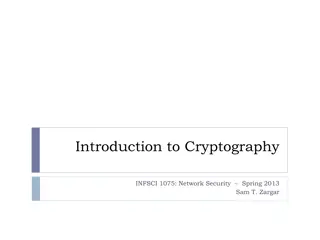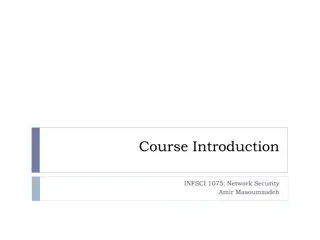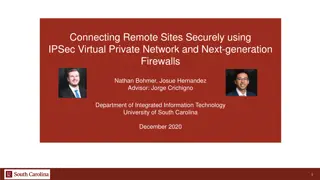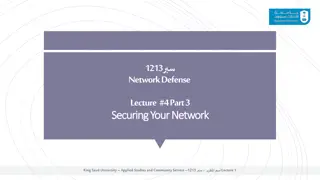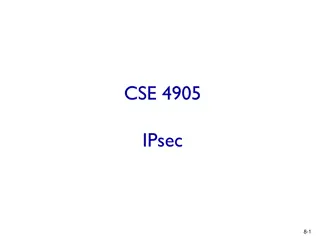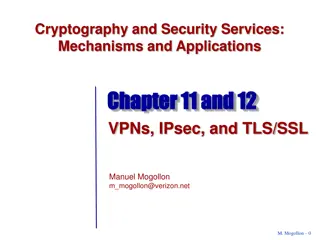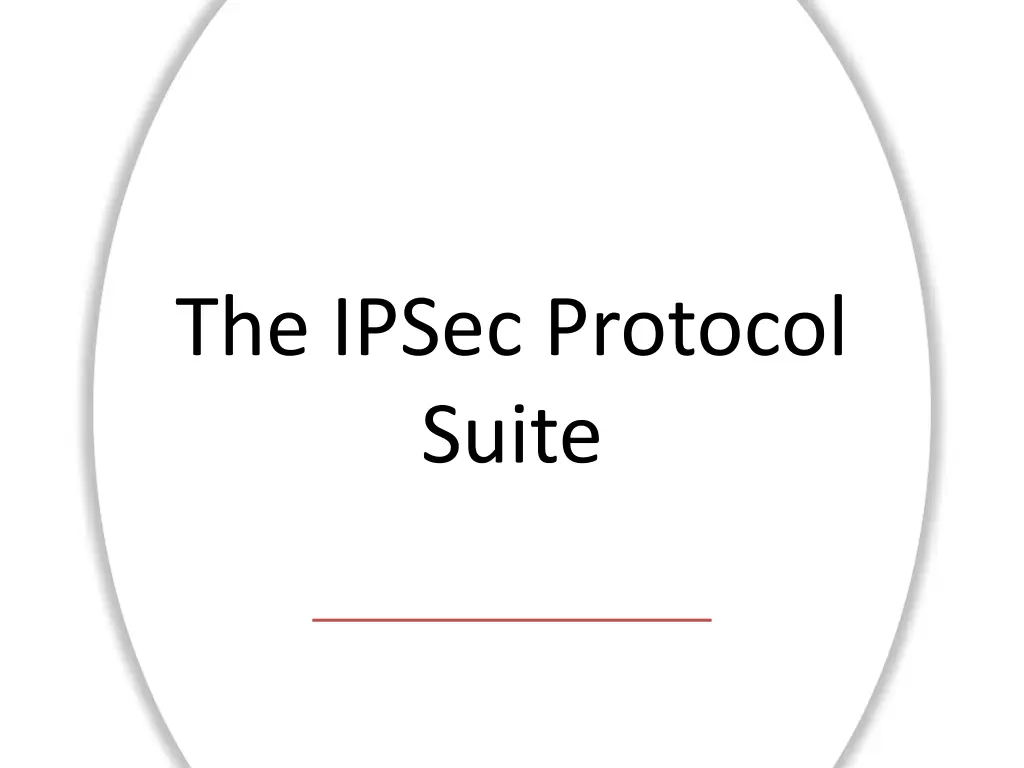
IPSec Protocol Suite Overview
Learn about the IPSec Protocol Suite, including protocols like ESP, AH, ISAKMP, and IKE. Discover the differences between AH vs. ESP, Encryption methods, and Tunnel mode vs. Transport mode. Understand the importance of authentication, confidentiality, and message integrity in setting up IPsec. Explore the use of MD5, SHA-1, DES, 3DES, AES encryption methods, and the differences between IKE and manual keys in establishing security associations.
Download Presentation

Please find below an Image/Link to download the presentation.
The content on the website is provided AS IS for your information and personal use only. It may not be sold, licensed, or shared on other websites without obtaining consent from the author. If you encounter any issues during the download, it is possible that the publisher has removed the file from their server.
You are allowed to download the files provided on this website for personal or commercial use, subject to the condition that they are used lawfully. All files are the property of their respective owners.
The content on the website is provided AS IS for your information and personal use only. It may not be sold, licensed, or shared on other websites without obtaining consent from the author.
E N D
Presentation Transcript
The IPSec Protocol Suite
IPSec IPsec is a suite of protocols. It consists of: Protocols that provide encryption-authenticity of the data stream (ESP, AH) Protocols that implement the initial key exchange to realize the encrypted stream (+ ISAKMP IKE).
Set up Ipsec (1) http://www.unixwiz.net/techtips/iguide-ipsec.html#flavors AH vs ESP AH (authenticate) provides authentication and message integrity, but it does not provide confidentiality ESP (encrypt+authenticate) provides authentication, confidentiality and message integrity check
Set up Ipsec (2) Tunnel mode vs Transport mode IPsec supports two modes of operation Transport Mode provides a secure connection between two endpoints (host- to-host) Only the IP s payload is encrypted and not the header Computationally lighter Tunnel Mode gateway-to-gateway connection the entire IP packet is encrypted computationally expensive only the gateway needs support of the Ipsec suite
Set up IPsec (3) MD5 vs SHA-1 vs DES vs 3DES vs AES vs blah blah blah Encryption methods: In Authentication mode, ciphers are used to calculate an Integrity Check Value (ICV) over the packet's contents. ICV it's usually built on top of a cryptographic hash such as MD5 or SHA-1. It incorporates a secret key known to both ends, and this allows the recipient to compute and check the ICV in the same way. In Encryption mode, ciphers are used with a secret key to encrypt the data before transmission (algorithms such as DES, 3DES, Blowfish, AES).
Set up Ipsec (4) IKE vs manual keys The Internet Key Exchange protocol is used to establish a security association (SA) used to establish a shared session secret, that is, a shared key corresponding to the session to be established from the shared secret are then derived encryption keys that will be used for the next communication. Manual keys require manual entry of the secret values for key exchange (occurs out-of-band) Main mode vs aggressive mode efficiency-versus-security tradeoff during the initial key exchange (IKE). Main mode requires 6 packets back and forth, but affords complete security during the establishment of an IPsec connection Aggressive Mode uses half the exchanges providing a bit less security because some information is transmitted in cleartext.
Standard IP Datagram (1) http://www.unixwiz.net/techtips/iguide-ipsec.html#ip ver version of the protocol hlen IP Header length, as a four-bit quantity of 32- bit words. A standard IPv4 header is always 20 bytes long (5 words). TOS Type of Service. Specifies how the datagram should be handled (optimize for bandwidth? Latency? Low cost? Reliability?) pkt len Overall packet length in bytes (up to 65535). This count includes the bytes of the header. ID Used to associate related packets that have been fragmented flgs Bits used for control and protocol datagram fragmentation
Standard IP Datagram (2) http://www.unixwiz.net/techtips/iguide-ipsec.html#ip frag offset tells the offset (measured in blocks of 8 bytes) of a particular fragment TTL This is the Time to Live of the datagram. proto Shows the code associated with the protocol used in the data field of the IP datagram, for example the TCP protocol is associated with the code 6, for UDP code 17. Other protocols (47, GRE. 50, ESP. 51, AH) header checksum it's designed to detect errors in transit. This is not a cryptographic checksum, and it doesn't cover any part of the datagram that follow the IP header.
Standard IP Datagram (3) http://www.unixwiz.net/techtips/iguide-ipsec.html#ip src IP address Shows the IP address associated with the host of the sender of the datagram (32-bit) dst IP address Shows the IP address associated with the host of the recipient of the datagram IP Options Options (optional and not used a lot) for more specific uses of the protocol. Payload Data in transit.
AH: Authentication Only (1) AH is used to authenticate, but not encrypting, IP traffic serves the purpose of ensuring that we're really talking to who we think we are, detecting alteration of data while in transit, and (optionally) to guard against replay by attackers who capture data from the wire and attempt to re-inject that data back onto the wire at a later date Authentication is performed by computing a cryptographic hash-based message authentication code over nearly all the fields of the IP packet (excluding those which might be modified in transit, such as TTL or the header checksum), and stores this in a newly-added AH header
AH: Authentication Only (2) http://www.unixwiz.net/techtips/iguide-ipsec.html#ah next hdr This identifies the protocol type of the following payload. AH len Defines the length of the whole AH header Reserved This field is reserved for future use and must be zero. Security Parameters Index identifies the parameters of current security combined with the pair of IP addresses. Sequence Number This is a monotonically increasing identifier that's used to assist in anti-replay protection. Authentication Data Contains the Integrity Check Value (ICV)
AH Transport Mode (2) It s conversation between two hosts. This protection guarantees authentication only. Only the payload of the IP datagram is handled by IPsec, inserting an header between the IP header and the upper levels used to protect an end-to-end
AH Transport Mode (3) When traffic is protected using AH in transport mode, AH is added as a new header between the IP header and the payload protocol (TCP, UDP, etc.). The IP header is changed to indicate that the next header to be treated is the AH protocol (next header field) Then the entire resulting IP packet, with the exception of some mutable IP header field, is authenticated by the hashing process and sent to the destination When the packet arrives at its destination and passes the authentication, the AH header is removed and the field Proto = AH header in the IP header is replaced with Next Protocol
AH Tunnel Mode (2) In tunnel mode a IP datagram is fully encapsulated in a new IP datagram using IPSec. the packet is sealed with an Integrity Check Value to authenticate the sender and to prevent modification in transit it encapsulates the full IP header as well as the payload, and this allows the source and destination addresses to be different from those of the encompassing packet (this allows formation of a tunnel)
AH Tunnel Mode (3) When the packet arrives at its destination, after the authentication check, the entire IP header and AH are stripped off The reconstituted packet could be delivered to the local machine or routed elsewhere (according to the destination IP address found in the encapsulated packet) Transport mode is used strictly to secure an end-to- end connection between two computers Tunnel mode is more typically used between gateways (routers, firewalls, or standalone VPN devices) to provide a Virtual Private Network
Transport or Tunnel? (2) There is no explicit "Mode" field in Ipsec what distinguishes Transport mode from Tunnel mode? with the next header field in the AH header When the next-header value is IP, it means that this packet encapsulates an entire IP datagram -> Tunnel mode. Any other value (TCP, UDP, ICMP, etc.) ->Transport mode
IPSec over UDP NAT friendly IPSec:
Authentication Algorithms (2) AH carries an Integrity Check Value in the Authentication Data portion of the header, built on top of standard cryptographic hash algorithms such as MD5 or SHA-1 Rather than use a straight checksum, it uses a Hashed Message Authentication incorporates a secret value while creating the ICV Though an attacker can easily recompute a hash, without the secret value he won't be able to recreate the proper ICV Code (HMAC) which
AH and NAT AH covers the integrity of the entire IP packet ESP does not cover the IP header with controls of any kind neither in Tunnel mode nor in Transport mode Works better with NAT
ESP Encapsulating Security Payload http://www.unixwiz.net/techtips/iguide-ipsec.html#esp
ESP Encapsulating Security Payload Its goal is to provide confidentiality and integrity checking and authenticity to communication. Unlike AH, the IP header is not covered by integrity checks. As with AH, it also provides Tunnel and Transport modes . It's possible to use the service of confidentiality, or only authentication services and integrity (and possibly anti-replay), or both services together.
ESP without encryption- use a NULL algorithm No confidentiality It only makes sense if combined with ESP authentication
ESP with encryption Adding encryption makes ESP a bit more complicated because the encapsulation surrounds the payload rather than preceding it as with AH ESP includes header and trailer fields to support the encryption and optional authentication DES, triple-DES, AES, and Blowfish are possible algorithms. Their use for a particular connection is specified by Security Associations (SA)
ESP with encryption HMAC as AH authentication is only for the ESP header and encrypted payload (the full IP packet isn t covered) When an outsider examines an IP packet containing ESP data, it's essentially impossible to make any real guesses about what's inside an ESP payload except for the usual data found in the IP header (particularly the source and destination IP addresses). It s only possible to know that it's ESP data
ESP Transport Mode encapsulates just the datagram's payload and it is designed strictly for host-to-host communications The original IP header is left in place the source and destination IP addresses are unchanged
ESP Tunnel Mode encapsulates an entire IP datagram
Summary Transport Mode SA Tunnel Mode SA Authenticates the entire inner IP packet (inner header plus IP payload) plus selected portions of the outer IP header and outer IPv6 extension headers. Authenticates IP payload and selected portions of IP header and IPv6 extension headers. AH Encrypts IP payload and any IPv6 extension headers following the ESP header. ESP Encrypts entire inner IP packet. Encrypts IP payload and any IPv6 extension headers following the ESP header. Authenticates IP payload but not IP header. Encrypts entire inner IP packet. Authenticates inner IP packet. ESP with Authentication
Building a real VPN http://www.unixwiz.net/techtips/iguide-ipsec.html#vpn
Security Associations and the SPI http://www.unixwiz.net/techtips/iguide-ipsec.html#other SA: a one way logical connection between the sender and the receiver Identified by three parameters : Partner IP address Security Parameters Index (SPI) Identifier of the security protocol
Security Associations and the SPI Security Association Database (SADB) A database containing some SAs, present on the hosts Security Parameter Index (SPI) Unique index associated with each entry of the SADB Identifies the SA associated with a packet Security Policy Database (SPD) Stores the policy used to determine the SA type (indicates preferences on what type of SA are acceptable)
IPSec ISAKMP +IKE
Internet Security Association and Key Management Protocol ISAKMP protocol defines procedures and packet formats to establish, negotiate, modify, delete the security associations defines payloads for exchanging key generation and authentication data it s independent of the key generation technique, encryption algorithm and authentication mechanism
ISAKMP message An ISAKMP message consists of: Header + one or more payloads Transported in a transport protocol specifications require support for UDP
Header ISAKMP Initiator Cookie (64 bit): Cookie of entity that initiated SA establishment, SA notification, or SA deletion. (used to prevent DOS attacks) Responder Cookie (64 bit): Cookie responding entity; null in first message from initiator Next Payload (8 bit): Indicates the type of the first payload in the message; payloads are discussed in the next subsection MajorVersion (4 bit): Indicates major version of ISAKMP in use MinorVersion (4 bit): Indicates minor ISAKMP version in use. Exchange Type (8 bit): Indicates the type of exchange Flag (8 bit): Indicates specific options set for this ISAKMP exchange Message ID (32 bit): message Length (32 bit): Length of total message in octets of ISAKMP Header Unique ID for this Generic payload header
Payload ISAKMP Next Payload (8 bit): has a value of 0 if this is the last payload in the message; otherwise its value is the type of the next payload Payload length (8 bit): indicates the length in octets of this payload Generic payload header
ISAKMP Payload Types (1) Type Parameters Description SA (Security Association) Domain of interpretation, situation Used to negotiate security attributes and indicate the Domain of interpretation and Situation under which negotiation is taking place. P (Proposal) Proposal #, Protocol-ID, SPI Size, # of Transforms, SPI Used during SA negotiation; indicates protocol to be used and number of transforms. (transform = data processing algorithm, e.g. hmac-md5, etc ) T (Transform) Transform #, Transform-ID, SA Attributes Used during SA negotiation; indicates transform and related SA attributes
ISAKMP Payload Types (2) Type Parameters Description KE (Key Exchange) Key Exchange data Supports a variety of key exchange techniques. ID (Identification) ID Type, ID Data Used to exchange identification information CERT (Certificate) Cert Encoding, Certificater Data Used to transport certificates and other certificate- related information CR (Certificate Request) # Cert Types, Certificate Types, # Certificate Auths, certificate Authorities Used to request certificates; indicates the types of certificates requested and the acceptable certificate authorities HASH (Hash) Hash data Contains data generated by a hash function SIG (Signature) Signature Data Contains data generated by a digital signature function
ISAKMP Payload Types (3) Type Parameters Description NONCE(nonce) Nonce Data Contains a nonce N(Notification) DOI,Protocol-ID,SPI Size, Notify Message Type, SPI,Notification Data Used to transmit notification data, such as an error condition D (Delete) DOI,Protocol-ID, SPI Size, # of SPIs, SPI (one or more) Indicates an SA that is no longer valid
Payload Types (1) The SA payload is used to begin the establishment of an security association the Domain of Interpretation parameter identifies the DOI under which negotiation is taking place The Situation parameter defines the security policy for this negotiation (the levels of security required) The Proposal payload contains information used during SA negotiation indicates the protocol for this SA (ESP or AH), includes the sending entity's SPI and the number of transforms. The Transform payload defines a security transform to be used to secure the communications channel for the designated protocol The Transform # parameter serves to identify this particular payload so that the responder may use it to indicate acceptance of this transform The Transform-ID and Attributes fields identify a specific transform (e.g., 3DES for ESP, HMAC-SHA-1-96 for AH) with its associated attributes
Payload Types (2) The Key Exchange payload can be used for a variety of key exchange techniques(Oakley, Diffie-Hellman,..) The data field contains the data required to generate a session key and is dependent on the key exchange algorithm used The Identification payload is used to determine the identity of communicating peers and may be used for determining authenticity of information. Typically the ID Data field will contain an IPv4 or IPv6 address. The Certificate payload transfers a public-key certificate The Certificate Encoding field indicates the type of certificate The Certificate Request payload is used to request the certificate of the other communicating entity The payload may list more than one certificate type that is acceptable and more than one certificate authority that is acceptable
Payload Types (3) The Hash payload contains data generated by a hash function over some part of the message and/or ISAKMP state. This payload may be used to verify the integrity of the data in a message or to authenticate negotiating entities The Signature payload contains data generated by a digital signature function over some part of the message and/or ISAKMP state. This payload is used to verify the integrity of the data in a message and may be used for nonrepudiation services The Nonce payload contains random data used to guarantee liveness during an exchange and protect against replay attack The Notification payload contains either error or status information associated with this SA or this SA negotiation The Delete payload indicates one or more SAs that the sender has deleted from its database and that therefore are no longer valid
ISAKMP: message exchange Base allows key exchange and authentication material to be transmitted together. Minimizes the number of exchanges at the expense of not providing identity protection Identity Protection Expands the Base Exchange to protect the users' identities Authentication Only Used to perform mutual authentication, without a key exchange Aggressive Minimizes the number of exchanges at the expense of not providing identity protection Informational Used for one-way transmittal management of information for SA
(1) I R : SA; NONCE Begin ISAKMP-SA negotiation (2) R E : SA; NONCE Basic SA agreed upon (3) I R : KE; IDI ; AUTH Key generated; Initiator identity verified by responder (4) R E : KE; IDR;AUTH Responder identity verified by initiator; Key generated; SA established Notation : I = initiator R = responder * = signifies payload encryption after the ISAKMP header AUTH = authentication mechanism used

